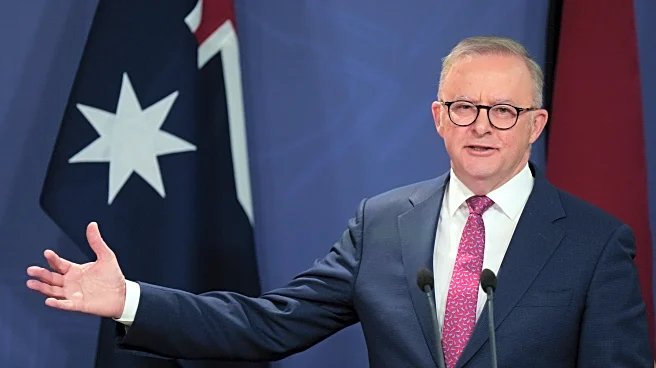What's Happening?
Gold prices experienced a significant decline on Tuesday, dropping as much as 6.3% to $4,082.03 per troy ounce after reaching an all-time high of $4,381.21 on Monday. This marked the steepest percentage
decline since April 2013. The sell-off followed weeks of heavy buying that had driven gold prices to overheated levels. Analysts attribute the decline to profit-taking by investors and the anticipation of renewed trade talks between American and Chinese officials. Despite the drop, gold prices saw a modest gain on Wednesday, trading at $4,141.48 per troy ounce. The decline in gold, a traditional safe-haven asset, coincided with a rebound in the US dollar and optimism over easing trade tensions between Washington and Beijing.
Why It's Important?
The recent sell-off in gold prices highlights the volatility in the precious metals market, which has seen historic gains in 2025. Gold's more-than-50% surge this year has surpassed previous volatile periods, driven by factors such as rising US government debt, political uncertainty, and speculation about further interest rate cuts by the Federal Reserve. The decline in gold prices could impact investors who have relied on the metal as a hedge against economic uncertainty. Additionally, the anticipated trade talks between the US and China could influence global economic conditions, affecting various industries and stakeholders. The outcome of these talks may either stabilize or further disrupt the market, depending on the agreements reached.
What's Next?
Trade representatives from the US and China are expected to meet later this week, with a planned meeting between Chinese leader Xi Jinping and US President Trump next week. The results of these discussions could have significant implications for the global economy and the gold market. Investors will be closely monitoring the talks for any signs of progress or setbacks. Additionally, the end of the Diwali festival in India, a major gold consumer, may reduce physical demand, potentially influencing future price movements. Market participants will also be watching for any changes in US monetary policy that could affect interest rates and, consequently, gold prices.













